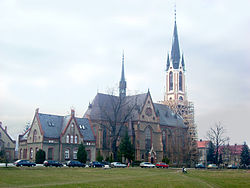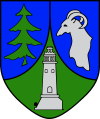Peterswaldau
| Pieszyce | ||
|---|---|---|

St Anthony Church
|
||
|
||
| Coordinates: 50°43′N 16°35′E / 50.717°N 16.583°E | ||
| Country |
|
|
| Voivodeship | Lower Silesian | |
| County | Dzierżoniów | |
| Gmina | Pieszyce (urban gmina) | |
| Town rights | 1962 | |
| Government | ||
| • Mayor | Dorota Konieczna-Enoezel | |
| Area | ||
| • Total | 63.61 km2 (24.56 sq mi) | |
| Population (2008) | ||
| • Total | 9,416 | |
| • Density | 150/km2 (380/sq mi) | |
| Website | http://www.um.pieszyce.pl | |
Pieszyce [pʲɛˈʂɨt͡sɛ] (German: Peterswaldau) is a town in Dzierżoniów County, Lower Silesian Voivodeship, in south-western Poland. Prior to 1945 it was in Germany.
It is situated in the historic Lower Silesia region on the northern slopes of the Owl Mountains, approximately 5 kilometres (3 mi) southwest of Dzierżoniów, and 56 kilometres (35 mi) southwest of the regional capital Wrocław.
As at 2008, the town has a population of 9,416.
The Waldhufendorf settlement in the Duchy of Silesia was first mentioned in a 1250 deed. In 1291 it fell with the lands of Świdnica to the Silesian Duchy of Jawor, which upon the death of Duke Bolko II the Small in 1368 was ruled by the Kings of Bohemia.
From the 16th century onwards, Peterswaldau developed as a centre of weaving. The Lords of Perswaldau had a castle erected in 1617, which was rebuilt in a Baroque style in 1710. The Saxon count Erdmann II of Promnitz acquired the estates in 1721 and gained the privilege to fabricate woven goods by Emperor Charles VI. The social hardship of the population in the course of the 19th century industrialisation was perpetuated by the famous Silesian author Gerhart Hauptmann in his play The Weavers, which is set in Peterswaldau.
...
Wikipedia


